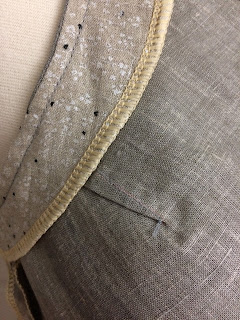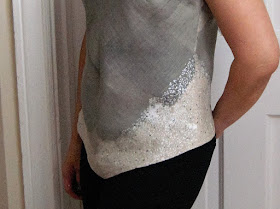This post is mostly about my experience sewing with mohair coating fabric. A more detailed review of the pattern used is posted here.
I bought this Mohair coating plaid from Mood Fabrics last year. I fell in love with the pastel shades. It is loosely woven but stable.
This is the wrong side of the fabric.
Unfortunately, while trying to research on how to sew with Mohair, there was not a lot of available information. I learned as I went along with the construction.
Choosing the Pattern:
Because my fabric was loosely woven and had a plaid design, I initially planned to sew a cape. However, I thought I would not get much use out of it as I prefer traditional coats. So I eventually settled for Butterick 6385 which is a fitted coat with princess seams, back yoke, forward shoulder, two piece sleeves and collar variation. It reminded me of the popular J. Crew Lady Day coat. However, because my fabric was not tightly woven, my finished coat did not really look that fitted.
Mohair Notes:
From Claire Shaeffer's Fabric Sewing Guide, "mohair is the best known and most commonly used hair fiber. It comes from angora goats which are raised in the US, Turkey and South Africa. Recognized by its fluffy, lustrous appearance, it feels soft and silky."
1. Pretreatment:
Dry cleaning is recommended. However, having two yards of mohair fabric dry cleaned was too costly so I tested a small piece before proceeding with Pam Erny's wool shrinking method. This involved putting the whole fabric in a dryer with a wet towel running it on high for 20-30 minutes.
2. Cutting the pattern:
*Mohair has a nap so it is important to remember this when laying out the pattern pieces. To help me remember, I usually pin a small piece of paper to the fabric with an arrow indicating the direction of the nap.
*Plaid matching. Janet Pray has a very helpful video tutorial on matching plaids. For pieces requiring two (as in two side front, two side back, etc) I cut one piece first then used that as the pattern for the second piece. That made it easier to match the plaid pattern.
*I cut the yoke and pocket flap on the bias purely for design but made sure that the facing was cut on grain to minimize stretching.
3. Interfacing and Underlining:
The pattern calls for fusing an interfacing to several of the pieces. Because mohair has a hairy nap that does not take well to hot pressing, I skipped the fusible interfacing and underlined all my pieces with silk organza. I quilted it along both horizontal and vertical grains so the mohair would not sag with time.
4. Sewing tools
*My fabric was woven with no stretch so I used a universal needle size 80.
*Thread was Guttermann 100% polyester.
*Aside from the straight stitch foot and buttonhole foot, I also used the walking foot which was essential because my fabric was thick.
*For topstitching, I used longer than normal stitches (no. 3.5 in Juki F600). Otherwise the short stitches tended to disappear in the nap.
*Although most of the seams were topstitched, I still needed to press open a couple of them. To avoid flattening the hairy nap, I put a terry cloth underneath the right side of the fabric. I then steamed the wrong side and pressed gently using my handy dandy mini pressing tool shown in the photo above. Because my fabric was underlined, I was able to sew seam open by catchstitching to the organza. This was done only in areas which were not topstitched.
5. Buttonholes
*It was impossible to mark the buttonhole placement using the guide included so I just measured the distances and used basting stitches to mark them down. For my coat, the center front line was 1" from the front opening edge. The distance I used between buttonholes was 4".
*I tested several buttonhole stitches and decided the large and thick keyhole worked best. (Buttonhole pattern 08 for Juki F600).
*I used basting thread to mark buttonhole location.
*I placed a piece of Totally Stable paper over the area to be sewn to avoid needle getting stuck on the hairy fibers. I also protected the surrounding fabric area with a large piece of paper while trying to manipulate it underneath the buttonhole foot.
7. Lining
*I used silk charmeuse for the lining and it's a good thing that the pattern does not require one to stitch the lining hem to the coat hem along the entire length. As it turns out, the lining hem is just left free and that worked well for mohair because as mentioned above, it has a tendency to sag so it is best to leave it separate from the lining which is stable.
Here are pictures of the finished coat:
 |
| My coat appears significantly shorter than the pattern photo because I wanted a "car coat" length. |
Final notes:
Although I love my fabric and the final product, I probably will stay away from hairy fabric for a while. It is just too messy and left a lot of hairy fibers everywhere! The pattern however is a keeper. I definitely plan to use it again.
Butterick 6385























































